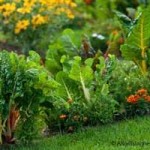
Veggie Landscape Garden
By Catherine Haug, Jan 21, 2017 (photo, right, from Mercola (2))
I am viewing the online docu-series: The Truth About Cancer, by Ty Bollinger, and I’m picking up on a few of garden/landscape tips that yield healthy plants and a healthier you when you eat them.
One of the things I’ve learned from this series is that cancer cells have more insulin receptors (that initiate take-up of sugar from the blood) than normal cells, and that cancer cells get their energy (life) from only two sources: sugar and glutamine (amino acid). So if you want to protect yourself from cancer or slow tumor growth, avoid sugar.
However, that doesn’t mean to avoid whole-food sources of sugar such as fruits and vegetables, because in whole-food form, the sugar is part of a larger matrix of fiber, antioxidants, and other phytochemicals that protect you. (Caveat #1: fruit juices don’t provide this protection because the matrix is broken, so eat your fruits whole; caveat #2: those fruits and veggies should be organically grown for maximum benefit).
But I digress. The purpose of this posting is to collect gardening and landscaping tips. I will update this posting as I learn more. (more…)



